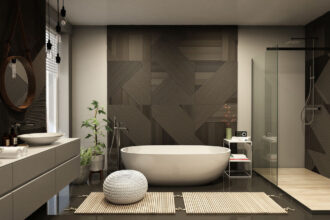Want to make your home feel effortlessly luxurious? It’s not just about stylish furniture or the perfect color palette it’s about mastering the art of texture layering. The right mix of materials, fabrics, and finishes adds depth, warmth, and sophistication to any space.
Whether you’re refreshing your living room, bedroom, or entire home, blending textures elevates interiors from ordinary to extraordinary.
The Power of Texture in Luxury Home Décor
Luxury in interior design isn’t just about expensive furniture or high-end finishes; it’s about how different textures work together to create a sense of depth and harmony. The right combination of soft and hard materials, matte and glossy surfaces, and rough and smooth finishes can transform a space into a visually engaging and inviting retreat.
When stepping into a well-designed luxury space, you’ll notice the seamless mix of materials: a plush velvet sofa against a sleek marble coffee table, a cozy wool rug softening a hardwood floor, or linen drapes complementing polished brass fixtures. These contrasts create layers of richness, making a home feel curated and well-thought-out rather than flat and uninspired.
Foundational Textures
To achieve a high-end look, start by selecting foundational textures that will define the room. Walls, ceilings, and flooring form the backdrop for your design, and their textures will dictate how the rest of the elements interact.
Building Elegance from the Ground Up
For walls, Venetian plaster, textured wallpaper, or wood paneling can add depth and character. If you prefer a modern aesthetic, a matte finish in neutral tones allows other materials to shine.
Flooring plays a crucial role in luxury interiors. Herringbone wood flooring exudes elegance, marble tiles add a polished effect, and plush living room rugs introduce warmth and comfort. The key is to choose a base texture that allows for a seamless layering of other materials while maintaining a cohesive, upscale feel.
Layering Soft and Hard Textures for a Balanced Look
A well-balanced interior incorporates both soft and hard textures to avoid a space feeling too harsh or overly plush. Soft textures like velvet, cashmere, and faux fur provide warmth, making a room feel cozy and inviting. On the other hand, hard materials like glass, stone, and metal introduce structure and sophistication.
Consider a seating area with a leather armchair, a chunky knit throw, and a polished stone side table. The juxtaposition of these textures adds depth and dimension to the design. Similarly, mixing a sleek dining table with upholstered chairs creates an interesting contrast that prevents the space from feeling too sterile or rigid.
The Art of Mixing Natural and Synthetic Materials
One of the secrets to achieving a refined look is blending organic and synthetic materials to create a dynamic contrast. Natural textures such as wood, jute, cotton, and linen bring an earthy, organic warmth, while high-gloss finishes, acrylic, and lacquered surfaces inject a modern, polished aesthetic.
For instance, pairing a rough-hewn wooden coffee table with a glass or metal sculpture achieves a high-end designer effect. A rattan or woven pendant light can soften the starkness of a contemporary kitchen, and a leather-upholstered bed frame can bring richness to an otherwise minimalist bedroom.
Playing with Light and Shadow to Elevate Texture
Lighting is a crucial but often underestimated component of texture layering. The way light interacts with different materials can enhance depth and bring out the richness of textures in a space.
Natural light highlights the organic beauty of wood grain, linen, and stone, while artificial lighting can strategically create contrast. A well-placed wall sconce can cast soft shadows on textured wallpaper, accent lighting can emphasize the glossy finish of a lacquered cabinet, and recessed lighting can bring out the depth of a coffered ceiling.
Mirrors and reflective surfaces also play a role in amplifying textures. A mirrored coffee table, a metallic vase, or high-gloss cabinetry can catch the light and add an element of glamour to a room.
Fabric and Upholstery Choices for a Luxe Ambiance
Fabric choices can make or break the luxurious feel of a space. Premium upholstery materials like velvet, leather, bouclé, and silk are often used in high-end interiors because of their rich texture and sophisticated appearance.
When layering fabrics, vary the texture and weight for a more curated effect. A linen sofa can be complemented by a soft cashmere throw and silk accent pillows. Heavy velvet drapes add drama and elegance, while sheer linen curtains bring an airy, delicate feel to a space.
Accent Pieces and Décor Elements that Introduce Texture
The right decorative accents can elevate a space without overwhelming it. Throw pillows, chunky-knit blankets, woven baskets, ceramic vases, and sculptural objects are perfect for subtly adding texture. A large-scale canvas painting, a macrame wall hanging, or a framed textile piece can add both visual interest and tactile contrast.
Best Textures for Different Design Styles
| Design Style | Best Soft Textures | Best Hard Textures |
| Modern Luxury | Velvet, bouclé, silk | Glass, lacquered wood, high-gloss metals |
| Rustic Chic | Wool, linen, jute | Reclaimed wood, matte stone, wrought iron |
| Classic Elegance | Silk, cashmere, velvet | Marble, brass, polished wood |
| Minimalist | Cotton, felt, linen | Concrete, glass, brushed metal |
Color and Texture
Texture and color go hand in hand when designing a luxurious space. A monochromatic color scheme with varied textures creates a rich, layered look. For instance, an all-white room with a mix of sheepskin, linen, and glossy ceramic accents feels opulent yet serene.
Alternatively, combining bold hues with textured materials can create an eye-catching statement. A deep navy velvet sofa against a brushed brass coffee table or a charcoal-hued wool rug under a sleek marble dining table instantly feels sophisticated.
Common Mistakes to Avoid When Mixing Textures
One of the biggest mistakes in texture layering is overloading a space with too many competing materials. Too many conflicting elements can make a room feel cluttered and chaotic rather than luxurious.
Another common pitfall is ignoring scale and proportion. A delicate lace curtain may look out of place next to a bulky, heavily textured sofa. Similarly, choosing low-quality finishes can cheapen the overall effect, so it’s always best to invest in a few key high-end pieces rather than filling a space with mass-produced items.
FAQs
What are the ways of mixing textures that will not make the space feel cluttered?
This includes maintaining some color consistency when mixing hard and soft textures. Stick to three to four dominant textures for a polished effect.
Can I get that luxe look on a budget?
Sure! Invest in the furniture pieces that carry the room with a plush rug or a velvet sofa, and mix in the décor using affordable textured accessories.
What other textures fit into modern luxury?
Gleaming marble, matte metals, soft bouclé, and smooth leather all work well for a sophisticated, modern vibe.
Tailpiece
Add texture to the house! Giving your house this layered texture will reflect a certain plush, decadent feeling with its mixture of soft and hard surfaces,-rich fabrics, and natural elements. Are you ready for transformation? Start playing around with small textural changes to create a marvel that will surely make your home into a chic, up-scale hideaway!

















